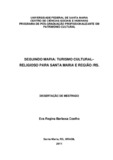| dc.creator | Coelho, Eva Regina Barbosa | |
| dc.date.accessioned | 2011-09-29 | |
| dc.date.available | 2011-09-29 | |
| dc.date.issued | 2011-02-28 | |
| dc.identifier.citation | COELHO, Eva Regina Barbosa. FOLLOWING MARIA: A CULTURAL AND RELIGIOUS TOURISM
FOR SANTA MARIA AND ITS REGIÃO / RS. 2011. 184 f. Dissertação (Mestrado em História) - Universidade Federal de Santa Maria, Santa Maria, 2011. | por |
| dc.identifier.uri | http://repositorio.ufsm.br/handle/1/10971 | |
| dc.description.abstract | The city of Santa Maria, RS state, is well-known as a religious center of Marian devotion and is an attraction for pilgrims and visitors, mainly because of the annual
pilgrimage of Our Lady Medianeira . Silveira Martins, also in the central region of RS state, emerged linked to Santa Maria as host city of the fourth region of the Italian immigration in 1877. This town maintains a strong devotion for Mother Mary once this image was brought
from Italian immigrants. This relation and the characteristics of the popular devotion is what motivated this paper. Its main purpose is to collect data which will allow us to build a religious and cultural itinerary, involving pilgrimage places and devotion to Mother Mary in the central region of RS state, Brazil. As a geographical cut, it was established that the region between
Santa Maria and Silveira Martins would be the principal focus of this paper because of all the reasons mentioned above and because of the places selected, as the Sanctuaries and festivities that compose this itinerary, which follows: Diocesan Cathedral, Basilica of Our
Lady Medianeira , Sanctuary of Schoenstatt, Church of Our Lady Dores , in Santa Maria; Sanctuary of Our lady of Health and Sanctuary of Our Lady of Pompeii, in Silveira Martins. Methodologically, an exploratory research was used, employing a historical method of procedure, from the technique of bibliographical investigation, of observation and of the qualitative appreciation of the collected information. The conceptual categories discussed
told about Cultural Estate, Tourism, and the Catholic Identity of Rio Grande do Sul state, pilgrimage. The main findings are about the characterization of the religious identity of this region as a result of the propagation of the popular Catholicism, characterized by a devotional dimension mainly directed to the Marian cult, expressed currently in popular religious parties like pilgrimages, corteges and promises considered as inheritance of the
Portuguese settlers, Indians missionaries, black people, people from Açores and Italian immigrants. | eng |
| dc.format | application/pdf | por |
| dc.language | por | por |
| dc.publisher | Universidade Federal de Santa Maria | por |
| dc.rights | Acesso Aberto | por |
| dc.subject | Patrimônio cultural | por |
| dc.subject | Turismo | por |
| dc.subject | Guia turístico religioso-cultural | por |
| dc.subject | Devoção Mariana | por |
| dc.subject | Romarias em Santa Maria e Silveira Martins | por |
| dc.subject | Cultural estate | eng |
| dc.subject | Tourism | eng |
| dc.subject | Religious-cultural touristic intinerary Marian devotion | eng |
| dc.subject | Pilgrimages at Santa Maria and Silveira Martins | eng |
| dc.title | Seguindo Maria: turismo cultural - religioso para Santa Maria e região/RS | por |
| dc.title.alternative | Following Maria: a cultural and religious tourism for Santa Maria and its região/RS | eng |
| dc.type | Dissertação | por |
| dc.description.resumo | A cidade de Santa Maria/RS destaca-se como centro religioso de devoção mariana, foco de atração de peregrinos e visitantes, principalmente por ocasião da romaria anual de Nossa Senhora Medianeira. Silveira Martins, também na região
central do Estado, surgiu ligada a Santa Maria, como sede da Quarta Colônia de Imigração Italiana, em 1877. Esta cidade, hoje, conserva forte devoção a Maria, trazida pelos imigrantes da Itália. Tal relação e as características da devoção popular
nelas guardada é que moveu este trabalho. O objetivo principal consistiu em reunir subsídios que permitam construir um guia turístico cultural-religioso, envolvendo locais de peregrinação e devoção à Virgem Maria na região central do Rio Grande do Sul/BR. Como recorte geográfico, estabeleceu-se como foco de estudo a região compreendida no espaço geográfico e culturalmente delimitado pelos municípios de
Santa Maria e Silveira Martins, pelos motivos já apresentados e porque neles foram selecionados os Santuários e festas que compõem o guia turístico proposto: Catedral Diocesana, Basílica de Nossa Senhora Medianeira, Santuário de
Schoenstatt, Igreja de Nossa Senhora das Dores, em Santa Maria; Santuário de Nossa Senhora da Saúde e Santuário de Nossa Senhora da Pompéia, em Silveira Martins. Metodologicamente, usou-se a pesquisa de caráter exploratório, a partir da técnica de investigação bibliográfica, da observação e apreciação qualitativa das informações coletadas. As categorias conceituais discutidas versaram sobre Patrimônio Cultural, Turismo e Identidade Religiosa Católica do Rio Grande do Sul, Peregrinação e Romarias. As constatações principais dizem respeito à caracterização da identidade religiosa da região como resultado da propagação do catolicismo popular, caracterizado por uma dimensão devocional, principalmente, e voltado para o culto mariano, expresso atualmente em festas religiosas populares
com procissões, romarias, promessas e ex-votos, expressões estas consideradas aqui como herança dos povoadores portugueses, indígenas missioneiros, negros, açorianos e imigrantes italianos. | por |
| dc.contributor.advisor1 | Padoin, Maria Medianeira | |
| dc.contributor.advisor1Lattes | http://lattes.cnpq.br/7863155517478900 | por |
| dc.contributor.referee1 | Borin, Marta Rosa | |
| dc.contributor.referee1Lattes | http://lattes.cnpq.br/5887358764231724 | por |
| dc.contributor.referee2 | Moesch, Marutschka Martini | |
| dc.contributor.referee2Lattes | http://lattes.cnpq.br/4591055346328481 | por |
| dc.creator.Lattes | http://lattes.cnpq.br/4439148582867270 | por |
| dc.publisher.country | BR | por |
| dc.publisher.department | História | por |
| dc.publisher.initials | UFSM | por |
| dc.publisher.program | Programa de Pós-Graduação em Patrimônio Cultural | por |
| dc.subject.cnpq | CNPQ::CIENCIAS HUMANAS::HISTORIA | por |


